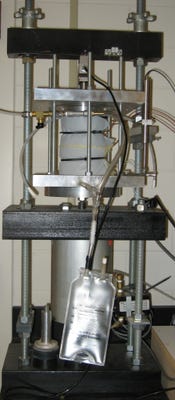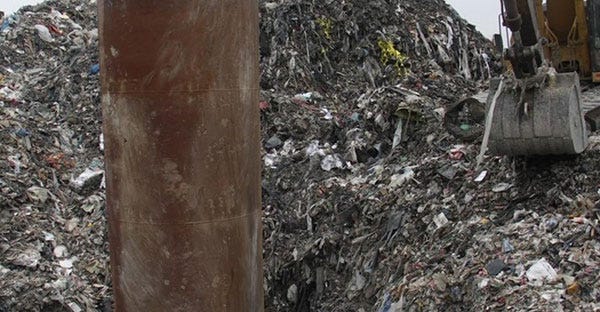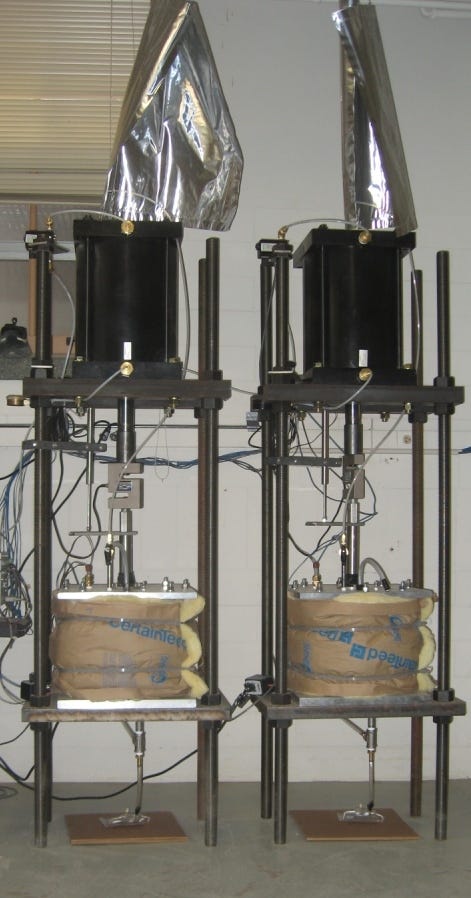Using compression in bioreactor landfills to enhance municipal solid waste settlement for short- and long-term sustainability.
October 1, 2012
Christopher A. Bareither, Ph.D.
Municipal solid waste (MSW) landfills have evolved during the past half century from uncontrolled dump sites to sophisticated systems that are environmentally sound and economically viable. Modern MSW landfills employ engineered barrier systems that have minimized environmental contamination concerns, such as leachate seeps into groundwater and greenhouse gas emissions into the atmosphere.
In addition to our ability to efficiently and effectively manage MSW in modern landfills, research during the past few decades has expanded our knowledge of the numerous advantages of operating MSW landfills as bioreactors. Whereas conventional landfills are operated with minimal waste decomposition due to waste sequestration as the primary objective, bioreactor landfills are operated with liquid, air, and/or nutrient (e.g., wastewater treatment biosolids) additions to enhance waste decomposition.
The most common approach to operating bioreactor landfills is to recirculate leachate, which enhances waste moisture content and distributes an active anaerobic microbial community throughout the waste mass. This anaerobic bioreactor approach has been widely documented to enhance waste decomposition, treat leachate in situ, increase methane generation, and accelerate waste settlement.
The issue of MSW settlement is significant to all stages of a landfill, from siting and regulation to post-closure monitoring. The amount of waste that can be placed in a given landfill is regulated in terms of airspace, i.e., the maximum volume waste can occupy. An increase in the amount of waste that can be placed within a given airspace increases potential landfill revenue via waste tipping fees. When the waste mass of a landfill fills the allotted airspace, a final cover is required to minimize long-term environmental contamination concerns. The integrity of the final cover is critical to maintaining effective waste sequestration from the environment; thus, minimizing post-closure waste settlement is directly related to maintaining final cover integrity and minimizing long-term maintenance.
The ability to enhance MSW settlement during filling operations allows for a greater amount of waste to be placed within a landfill’s given airspace. Additionally, long-term concerns of final cover integrity and post-closure care are reduced when the majority of MSW settlement occurs during filling and prior to landfill closure.
Operating MSW landfills as bioreactors provides an opportunity to enhance MSW settlement during filling. While numerous researchers have documented an increase in MSW settlement due to anaerobic biological activity in MSW bioreactor landfills, our ability to quantify the effects of enhanced MSW settlement and predict MSW compression behavior has been ad hoc at best.
A recent project focused on developing predictive tools for sustainable solid waste management in bioreactor landfills was completed through a partnership consisting of academia (University of Wisconsin-Madison and North Carolina State University), industry (regulatory agencies, consulting firms and waste industry leaders), and the National Science Foundation. In regards to MSW settlement, the following key developments evolved from this project: (1) a mechanistic understanding of abiotic and biotic contributions of MSW compression; (2) a comparison of MSW compression behavior and settlement model parameters between laboratory- and field-scale experiments; and (3) a systematic approach for generating a priori predictions of MSW settlement in bioreactor landfills.
Mechanics of Waste Compression
Municipal solid waste compression in bioreactor landfills typically consists of three processes: (i) immediate compression, (ii) mechanical creep, and (iii) biocompression. Immediate compression is an abiotic process that occurs in response to an increase in vertical stress. The term “immediate” has been adopted to distinguish the initial rapid settlement that occurs in unsaturated MSW from traditional primary settlement in soils, which involves dissipation of pore water to yield volume change. Mechanical creep also is an abiotic compression process that involves time-dependent yielding and reorientation of MSW constituents under constant vertical stress.
 In bioreactor landfills, recirculation of leachate through the waste mass or introduction of other supplemental liquids causes moisture-induced softening that can temporarily increase the rate of mechanical creep compression. Biocompression is a biotic compression process and is primarily associated with anaerobic decomposition of the organic, biodegradable MSW fraction. Mechanical creep occurs simultaneously with biocompression as MSW constituents continuously yield and reorient during active waste decomposition.
In bioreactor landfills, recirculation of leachate through the waste mass or introduction of other supplemental liquids causes moisture-induced softening that can temporarily increase the rate of mechanical creep compression. Biocompression is a biotic compression process and is primarily associated with anaerobic decomposition of the organic, biodegradable MSW fraction. Mechanical creep occurs simultaneously with biocompression as MSW constituents continuously yield and reorient during active waste decomposition.
Each of the three MSW compression processes has unique characteristics that allow for independent parameterization in MSW settlement models. The systematic progression of MSW compression in bioreactor landfills (i.e., immediate compression Þmechanical creep Þbiocompression Þfinal mechanical creep) provides a framework for coupling predictions of independent compression phases into a holistic approach to predict short-term and long-term MSW settlement.
Although this modeling framework has been used previously, research from this project enhanced our ability to determine both compression rates and temporal transition times (i.e., settlement model parameters) for each of the compression processes. Settlement model parameters for each of the compression processes can be measured in laboratory-scale experiments or derived from empirical relationships that relate model parameters to waste composition and material properties (i.e., dry unit weight and moisture content).
Field- and Laboratory-Scale Experiments
Municipal solid waste settlement experiments at both laboratory- and field-scale have been commonplace for the past few decades to evaluate waste behavior in conventional and bioreactor landfills. To build and expand on these past studies, a coupled laboratory- and field-scale experimental program was implemented where waste composition and material properties, environmental factors (e.g., waste temperature), and operational conditions (e.g., waste compaction and leachate dosing) were kept as consistent as possible across the experimental scale.
 Pictures of the field-scale experiment and different sized laboratory-scale experiments are shown in Fig. 1. The field-scale experiment employed a steel cylindrical drainage lysimeter buried in the waste mass of an operating landfill; concurrently, laboratory-scale compression cells were fabricated such that stress and temperature could be controlled and leachate and gas could be managed.
Pictures of the field-scale experiment and different sized laboratory-scale experiments are shown in Fig. 1. The field-scale experiment employed a steel cylindrical drainage lysimeter buried in the waste mass of an operating landfill; concurrently, laboratory-scale compression cells were fabricated such that stress and temperature could be controlled and leachate and gas could be managed.
Waste used to fill the field-scale experiment was excavated directly from the waste mass of the operating landfill where the lysimeter was placed. This waste was also used for all laboratory-scale experiments. To control composition between different experiment scales, MSW constituents were shredded in a high-torque, slow-speed shredder to adhere with pre-determined cell diameter-to-maximum waste particle size criteria. Waste shredding was identified as a necessary procedure for laboratory preparation of MSW specimens.
Experiment results showed that MSW compression behavior is comparable between different scales when waste composition and material properties are similar. Thus, MSW shredding for the preparation of laboratory-scale experiments is recommended such that waste composition and material properties can be maintained consistent with field-scale operations.
Predicting MSW Settlement in Bioreactor Landfills
As discussed previously, there are specific abiotic and biotic MSW compression processes that contribute to overall waste settlement in bioreactor landfills. Abiotic processes are associated with physical compression of the waste structure. Settlement model parameters for abiotic compression processes of immediate compression and mechanical creep directly measured in laboratory-scale experiments are applicable to predicting field-scale compression.
Alternatively, these abiotic settlement model parameters can be estimated from correlations with the waste compressibility index or the ratio of cellulose plus hemicellulose to lignin. The former parameter was created as part of this study and combines water content, dry unit weight, and the percent contribution of organic waste, whereas the latter parameter is based on the relative contributions of biodegradable (cellulose and hemicellulose) and recalcitrant (lignin) organic matter in MSW.
 The biotic compression process (i.e., biocompression) was found to be scale-dependent. Scale effects on the elapsed time for transition from mechanical creep to biocompression and on the first-order decay-rate (commonly used to predict the rate of biocompression) were attributed to waste shredding. Smaller waste specimens showed a more rapid onset and higher rate of biocompression compared to larger waste specimens. The average size of the waste particles decreased with decreasing diameter of the waste specimens, and correspondingly the specific surface (i.e., surface area per mass) increased and pore size decreased with a decrease in average waste particle size. The smaller waste specimens contained waste matrices that provided increased moisture retention and increased waste particle surface area for biological activity.
The biotic compression process (i.e., biocompression) was found to be scale-dependent. Scale effects on the elapsed time for transition from mechanical creep to biocompression and on the first-order decay-rate (commonly used to predict the rate of biocompression) were attributed to waste shredding. Smaller waste specimens showed a more rapid onset and higher rate of biocompression compared to larger waste specimens. The average size of the waste particles decreased with decreasing diameter of the waste specimens, and correspondingly the specific surface (i.e., surface area per mass) increased and pore size decreased with a decrease in average waste particle size. The smaller waste specimens contained waste matrices that provided increased moisture retention and increased waste particle surface area for biological activity.
Thus, when evaluating biocompression in laboratory-scale experiments an appropriate scale factor must be applied to settlement model parameters that transform the parameters appropriately for field-scale prediction. An empirical relationship was created to provide guidance on transforming laboratory-derived biocompression parameters for field-scale prediction.
Moving Forward
The study summarized herein provided baseline evidence that the systematic evaluation of MSW in laboratory-scale experiments can be representative of field-scale behavior. This finding is critical to subsequent evaluations of MSW behavior in laboratory-scale bioreactors as well as to developments and improvements in our ability to forecast settlement in full-scale landfills. However, this is only one study, and the effects of waste properties, environmental factors, and operational conditions were not holistically evaluated. Bioreactor landfills provide an opportunity to enhance traditional MSW landfill operations. The ability to predict MSW settlement behavior in bioreactor landfills can improve the economic benefits landfilling MSW, enhance land stewardship, reduce post-closure concerns, and perhaps most importantly instill confidence in landfill owners and operators towards the adoption of bioreactor technology.
Dr. Christopher Bareither is an Assistant Professor of Civil and Environmental Engineering at Colorado State University. Findings from the study summarized in this article are published in the American Society of Civil Engineer’s Journal of Geotechnical and Geoenvironmental Engineering.
SIDEBAR: Chris Bareither will present “Comparison of Municipal Solid Waste Settlement Model Parameters Derived from Physical, Chemical, and Biological Processes” at the Global Waste Management Symposium in Phoenix as part of the Waste Properties track from 2:00 p.m. to 3:30 p.m. on Mon., Oct. 1.
You May Also Like


